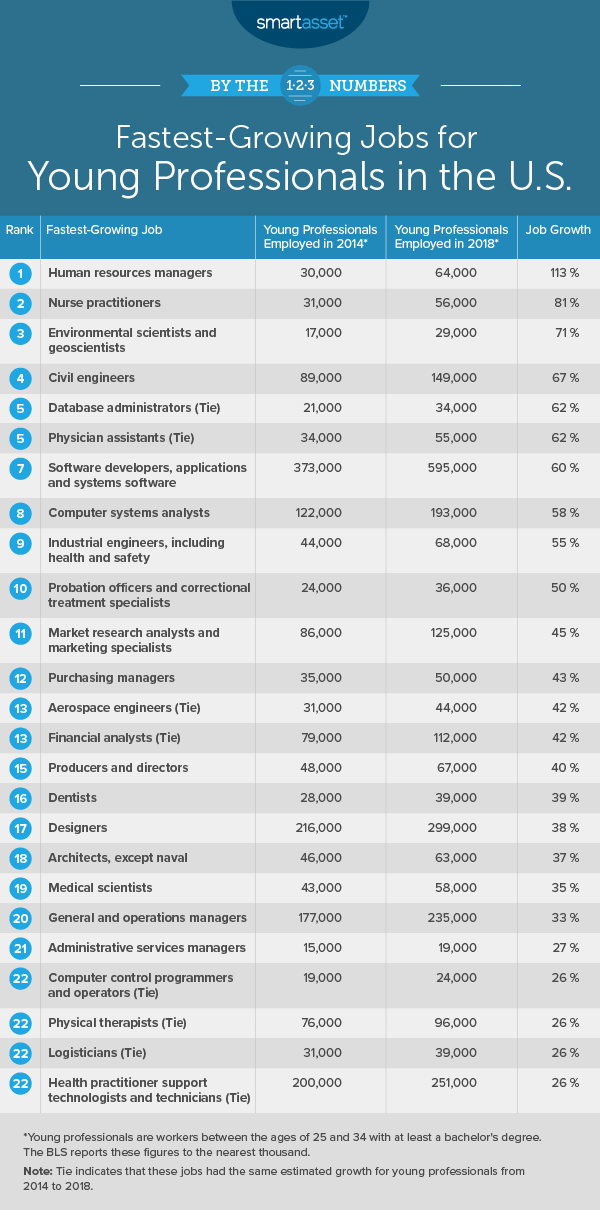
In 2014, there were almost 32 million workers in the U.S. between the ages of 25 and 34, and over five years, this number rose to more than 35 million, an increase of about 10%. Of those 35 million, about 13 million had a bachelor’s or advanced degree, or 16% more than workers who did in 2014. The 16% growth in educated young professionals varies by industry and occupation. Some industries and occupations have seen growth of workers with at least a bachelor’s degree that far outpaces 16% – growth that potentially allows much more flexibility in these professionals’ ability to save enough to meet their financial goals – while others have seen decreases in the number of educated young professionals working the field or job.
In this study, we looked at some of the fastest-growing jobs for young professionals. Using Bureau of Labor Statistics (BLS) data from 2014 and 2018, we ranked percentage growth by occupation for jobs with greater than 15,000 people between the ages of 25 and 34 in 2014, considering only occupations that require a bachelor’s degree or higher. For details on data sources and how we put together our findings, check out the Data and Methodology section below.
Key Findings
- The fastest-growing jobs for young professionals are high-paying ones. Eight of the top 10 fastest-growing jobs for young professionals have a median annual income greater than $80,000. In fact, four of the 10 have median salaries in the six-figures. Those four professions are human resources managers, nurse practitioners, physician assistants and software developers. While nurse practitioners and physician assistants typically have master’s degrees, the typical education needed to become a human resources manager or software developer is a bachelor’s degree.
- Tech makes a big appearance. Three of our top 10 fastest-growing jobs for young professionals are tech-focused. They include database administrators, software developers and computer systems analysts, ranking fifth, seventh and eighth, respectively. Somewhat expectedly, all three of these occupations have median annual salaries of greater than $80,000, with software developers generally making the most. But where should you be if you’re looking to make the most of working in this field? See our list of the best cities to work in tech.

1. Human Resources Managers
Working in nearly every industry, human resources managers plan and coordinate the administrative functions of an organization. With the increased focus on workplace culture across many industries, it is unsurprising that there are more human resources managers than there were five years ago. Between 2014 and 2018, the occupation grew by 33% from 236,000 employees to 313,000.
Though the overall occupation growth is substantial, growth for young professionals working in the occupation far outpaces overall growth. In 2014, there were 30,000 young professionals working as human resources managers, and in 2018, there were 64,000, an increase of 34,000 or about 113%. In 2014, approximately 13% of human resources managers were between the ages of 25 and 34 and in 2018, approximately 20% of those professionals fell in that age range. This is additionally unsurprising as many companies want young professionals to help form a desirable workplace culture for some of the other young professionals they are hiring.
2. Nurse Practitioners
Tied for sixth as one of the fastest-growing jobs for women of all ages, nurse practitioner ranks as the second-fastest-growing job for young professionals. Job growth for young professionals as nurse practitioners outpaces that of women working in this job. Between 2014 and 2018, there was an increase of approximately 81% in nurse practitioners between the ages of 25 and 34, compared to an increase of 58% in female nurse practitioners. Specifically, in 2014, there were 31,000 nurse practitioners between the ages of 25 and 34, and in 2018, there were 56,000. For women, there were 117,100 female nurse practitioners in 2014 and 184,900 in 2018.
The growth for both young professionals and women in the occupation correlates with overall growth in the occupation. Over the five-year time period from 2014 to 2018, the occupation overall expanded by about 66%. Nurse practitioners are increasingly able to perform many of the services previously provided only by doctors.
3. Environmental Scientists and Geologists
The occupation of environmental scientists and geologists has not grown substantially over the past five years despite increasing concerns about climate change on both local and national levels. Between 2014 and 2018, there was an increase of only 9,000 workers in the occupation, or 10%. However, the job growth for young professionals working as environmental scientists and geologists was about 71% over the five years, perhaps indicating a focus among younger generations on environmental protection.
Notably, this is the smallest occupation in terms of both total workers and young professional workers in our top 10. In 2018, there were 100,000 total workers in the field, 29,000 of whom were between the ages of 25 and 34. In contrast, the largest occupation in our top 10, software developers, ranking seventh, employed a total of 1,682,000 workers in 2018, of whom 595,000 were between the ages of 25 and 34.
4. Civil Engineers
With the exception of the health-related occupations in our top 10, a number of other occupations – such as database administrators and software developers – are office jobs. However, civil engineers work in a variety of locations and conditions. They typically spend some time working in an office, but they also spend time onsite monitoring operations and solving problems for specific projects. In 2014, there were 89,000 young professionals working as civil engineers, and in 2018, there were 149,000, an increase of 60,000 or about 67%.
5. Database Administrators (tie)
The total number of database administrators in the U.S. stayed constant at 108,000 between 2014 and 2018. Despite this, it is one of the fastest-growing jobs for young professionals. From 2014 to 2018, 13,000 more workers between the ages of 25 and 34 started working as database administrators.
The median annual salary for database administrators in 2018 was $90,070. While this is less than the median salary for software developers, it outpaces that of computer systems analysts, $88,740.
5. Physician Assistants (tie)
Physician assistant ties for fifth with database administrator in terms of job growth for young professionals. Like nurse practitioner, physician assistant is also one of the fastest-growing jobs for women of all ages according to our 2019 findings, ranking eighth in that study.
The difference between growth of young professional physician assistants and women physician assistants is smaller than that between young professional nurse practitioners and women nurse practitioners. As previously noted, there was an increase of about 81% in nurse practitioners between the ages of 25 and 34 compared to an increase of 58% in female nurse practitioners over the five-year time period leading up to 2018. In comparison, there was an increase of about 62% in young professional physician assistants and 52% in female physician assistants over that same time period.
7. Software Developers, Applications and Systems Software
More than half a million young professionals work as software developers, including both applications and systems software. Specifically, in 2018, there were 595,000 software developers working in the U.S. who were between the ages of 25 and 34. In part, the large number of young professional software developers is a result of the size of the occupation itself. It is the largest occupation of any in our top 10 by far. According to BLS data, there were a total of 1,682,000 software developers in the U.S. in 2018.
The number of software developers is expected to continue to grow, with the BLS predicting a strong job outlook for the occupation. The job growth from 2016 through 2026 is predicted to be 24%, which the BLS categorizes as much faster than average, relative to projections for all other occupations.
8. Computer Systems Analysts
There were 71,000 more computer systems analysts between the ages of 25 and 34 in 2018 than there were in 2014. That is approximately a 58% increase over the five years.
Median salary and job outlook for computer systems analysts slightly lags compared to software developers. In 2018, the median annual earnings for computer systems analysts was $88,740, more than $15,000 less than that of software developers. Additionally, the BLS predicts a 9% increase for computer systems analysts over the 10-year period leading up to 2026, 15% lower than the job growth predicted for software developers.
9. Industrial Engineers, including Health and Safety
Job growth for young professional industrial engineers is twice as fast as job growth for the occupation overall. In 2018, there were approximately 55% more industrial engineers between the ages of 25 and 34 than there were in 2014, but only about 27% more total workers in the field.
Like healthcare and tech-related fields, engineering tends to be a high-paying industry, and industrial engineers can expect to be well compensated. The median annual income for an industrial engineer in 2018 was $87,040.
10. Probation Officers and Correctional Treatment Specialists
Probation officers and correctional treatment specialists is perhaps our most unexpected fastest-growing job for young professionals. In 2014, there were 24,000 probation officers between the ages of 25 and 34, and in 2018, there were 36,000, resulting in an increase of about 50% the five years. This is particularly significant as the occupation overall only grew by about 4% over that same time period.
As a result of the fact that young professional growth far outpaced overall growth of the occupation, young professionals made up a much larger percentage of total probation officers in 2018 than they did in 2014. In 2014, 24% of all probation officers in the U.S. were between 25 and 34 years of age, and in 2018, 35% of them were in the same age range.
Data and Methodology
To find the fastest-growing jobs for young professionals, SmartAsset looked at employment data from 2014 and compared it to 2018. We considered only occupations that require a bachelor’s or advanced degree and filtered out any occupation that employed fewer than 15,000 people between the ages of 25 and 34 in 2014. We also filtered out any occupation with “other” and “miscellaneous” in the title due to lack of specificity. To rank the occupations, we looked at the percentage change in young professionals employed in each occupation from 2014 to 2018.
All data, including earnings data, comes from the Bureau of Labor Statistics. Employment data is reported to the nearest thousand and growth is estimated based on that reporting.
Tips for Saving for Retirement
- Smarter savings. As you grow your career, it’s important to grow your savings as well in order to make sure you have enough set aside for your future. Take advantage of your employer’s 401(k) match if available, and use a comprehensive retirement calculator to get a sense of what your situation might look like.
- Get financial help. Finding the right financial advisor that fits your needs doesn’t have to be hard. SmartAsset’s free tool matches you with financial advisors in your area in 5 minutes. If you’re ready to be matched with local advisors that will help you achieve your financial goals, get started now.
Questions about our study? Contact us at press@smartasset.com
Photo credit: ©iStock.com/katleho Seisa